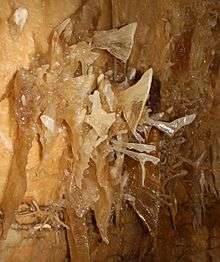Helictite

A helictite is a speleothem found in limestone caves that changes its axis from the vertical at one or more stages during its growth. They have a curving or angular form that looks as if they were grown in zero gravity. They are most likely the result of capillary forces acting on tiny water droplets, a force often strong enough at this scale to defy gravity.
Helictites are, perhaps, the most delicate of cave formations. They are usually made of needle-form calcite and aragonite. Forms of helictites have been described in several types: ribbon helictites, saws, rods, butterflies, "hands", curly-fries, and "clumps of worms." They typically have radial symmetry. They can be easily crushed or broken by the slightest touch. Because of this, helictites are rarely seen within arm's reach in tourist caves.
Timpanogos Cave National Monument in Utah has one of the largest collections of these formations in the world. The large numbers are also in the Jenolan Caves in Australia and in the Pozalagua Cave in Karrantza in Spain.
Formation
The growth of helictites is still quite enigmatic. To this day there has been no satisfactory explanation for how they are formed. Currently, formation by capillary forces is the most likely theory, but another theory based on wind formation is also viable.
Capillary forces
The most likely theory explains helictites as a result of capillary forces. If the helictite has a very thin central tube where the water flows like it does in straws, capillary forces would be able to transport water against gravity. This theory was inspired by some hollow helictites. However, the majority of helictites are definitely not hollow. Despite this, droplets can be drawn to the tips of existing structures and deposit their calcite load almost anywhere thereon. This can lead to the wandering and curling structures seen in many helictites.
Wind
Another theory names the wind in the cave as main reason for the strange look. Drops hanging on a stalactite are blown to one side, so the dripstone grows in that direction. If the wind changes, the direction of growth changes too. However this theory is very problematic, because wind directions change very often. The wind in caves depends on air pressure changes outside, which in turn depend on the weather. Wind caves are known to experience these windy conditions. The wind direction changes as often as the weather conditions outside change. But the dripstones grow very slowly – several centimeters in 100 years – meaning the wind direction would have to stay steady for long periods of time, changing for every fragment of a millimeter of growth. A second problem with this theory is that many caves with helictites have no natural entrance where wind could enter.
Piezoelectric forces
A theory is proposed that slowly changing geological pressure causing stresses on the crystals at the base alters the piezo electrostatic potential and causes particle deposition to be oriented in some relationship to the prevailing pressure orientation.
Bacterial
A recent theory which is supported by observation is that a prokaryotic bacterial film provides nucleation site for mineralization process. [1]
Helictite growth

A helictite starts its growth as a tiny stalactite. The direction of the end of the straw may wander, twist like a corkscrew, or the main part may form normally while small helictites pop out of its side like rootlets or fishhooks. In some caves, helictites cluster together and form bushes as large as six feet tall. These bushes grow from the floor of the cave. When helictites are found on cave floors, they are referred to as heligmites, though there is debate as to whether this is a genuine subcategory.
For an unknown reason, when the chemical composition of the water is slightly altered, the single crystal structure can change from a cylindrical shape to a conical one. In some of these cases, each crystal fits into the prior one like an inverted stack of ice cream cones.

History
The first detailed description of helictites was made in 1665 by Olaus Worm.
See also
References
- ↑ Tisato, N. et al., “Microbial mediation of complex subterranean mineral structures”, Sci. Rep. 5, 15525; doi: 10.1038/srep15525 (2015)
External links
- The Virtual Cave: Helictites
- Helictite or Eccentric?
- Does crystal splitting play a part in the curvature of helictites? (Abstract) By George W. Moore, Journal of Cave and Karst Studies, v. 62, p. 37 (2000).